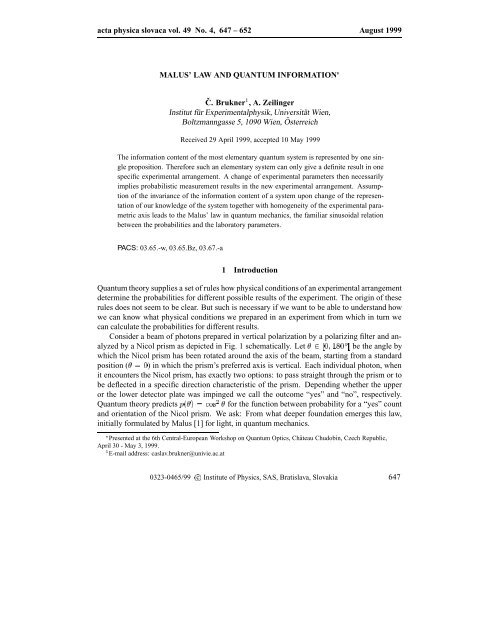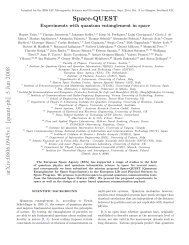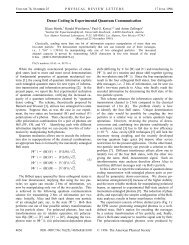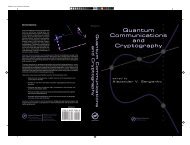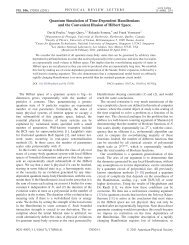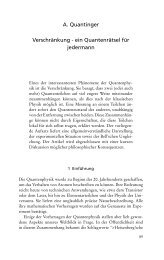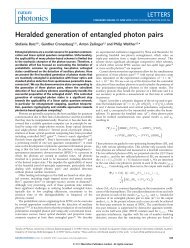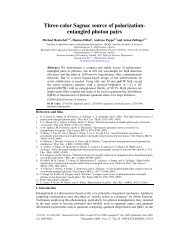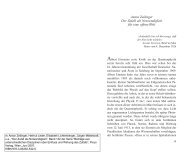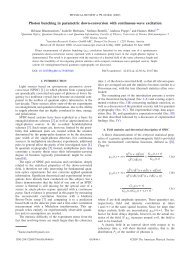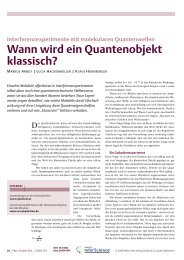acta physica slovaca vol. 49 No. 4, 647 â 652 ... - Universität Wien
acta physica slovaca vol. 49 No. 4, 647 â 652 ... - Universität Wien
acta physica slovaca vol. 49 No. 4, 647 â 652 ... - Universität Wien
You also want an ePaper? Increase the reach of your titles
YUMPU automatically turns print PDFs into web optimized ePapers that Google loves.
<strong>acta</strong> <strong>physica</strong> <strong>slovaca</strong> <strong>vol</strong>. <strong>49</strong> <strong>No</strong>. 4, <strong>647</strong> – <strong>652</strong> August 1999<br />
MALUS’ LAW AND QUANTUM INFORMATION <br />
Č. Brukner 1 , A. Zeilinger<br />
Institut für Experimentalphysik, Universität <strong>Wien</strong>,<br />
Boltzmanngasse 5, 1090 <strong>Wien</strong>, Österreich<br />
Received 29 April 1999, accepted 10 May 1999<br />
The information content of the most elementary quantum system is represented by one single<br />
proposition. Therefore such an elementary system can only give a definite result in one<br />
specific experimental arrangement. A change of experimental parameters then necessarily<br />
implies probabilistic measurement results in the new experimental arrangement. Assumption<br />
of the invariance of the information content of a system upon change of the representation<br />
of our knowledge of the system together with homogeneity of the experimental parametric<br />
axis leads to the Malus’ law in quantum mechanics, the familiar sinusoidal relation<br />
between the probabilities and the laboratory parameters.<br />
PACS: 03.65.-w, 03.65.Bz, 03.67.-a<br />
1 Introduction<br />
Quantum theory supplies a set of rules how <strong>physica</strong>l conditions of an experimental arrangement<br />
determine the probabilities for different possible results of the experiment. The origin of these<br />
rules does not seem to be clear. But such is necessary if we want to be able to understand how<br />
we can know what <strong>physica</strong>l conditions we prepared in an experiment from which in turn we<br />
can calculate the probabilities for different results.<br />
Consider a beam of photons prepared in vertical polarization by a polarizing filter and analyzed<br />
by a Nicol prism as depicted in Fig. 1 schematically. Let 2 [0 180 [ be the angle by<br />
which the Nicol prism has been rotated around the axis of the beam, starting from a standard<br />
position ( =0) in which the prism’s preferred axis is vertical. Each individual photon, when<br />
it encounters the Nicol prism, has exactly two options: to pass straight through the prism or to<br />
be deflected in a specific direction characteristic of the prism. Depending whether the upper<br />
or the lower detector plate was impinged we call the outcome “yes” and “no”, respectively.<br />
Quantum theory predicts p() = cos 2 for the function between probability for a “yes” count<br />
and orientation of the Nicol prism. We ask: From what deeper foundation emerges this law,<br />
initially formulated by Malus [1] for light, in quantum mechanics.<br />
Presented at the 6th Central-European Workshop on Quantum Optics, Château Chudobín, Czech Republic,<br />
April 30 - May 3, 1999.<br />
1 E-mail address: caslav.brukner@univie.ac.at<br />
0323-0465/99 c Institute of Physics, SAS, Bratislava, Slovakia <strong>647</strong>
648 Č Brukner, A Zeilinger<br />
Fig. 1. Measurement of the polarization of the photon. Photon from the source passes through the vertical<br />
oriented polarizator, a Nicol prism oriented at the angle to the polarizator, and then it impinges one<br />
of the detector plates behind the Nicol prism. Depending whether the upper or the lower detector plate<br />
was impinged we call the outcome “yes” and “no”, respectively. We ask: From what deeper foundation<br />
emerges the well-known function p() = cos 2 between the probability for a “yes” outcome and the<br />
angle of orientation of the Nicol prism?<br />
2 Principle of Quantization of Information<br />
Any <strong>physica</strong>l system can be described by a set of propositions together with their truth values -<br />
true or false. Any propositions we might assign to a system are arrived only by observation and<br />
represent our knowledge, i.e., information, of an object gained through observation.<br />
Consider encoding information into the polarization of photons. Let us consider our specific<br />
example of a photon with vertical polarization. The information content of the photon can then<br />
be expressed as a truth value of the proposition: “The polarization of the photon is vertical”.<br />
This permits the prediction of individual outcomes with certainty only for the case when we<br />
actually perform a measurement in the vertical-horizontal polarization basis. Measurement for<br />
any other measurement basis must necessarily be probabilistic. We suggest that the reason for<br />
this is a principle of quantization of information [2]: The most elementary quantum system<br />
represents the truth value of one proposition only. This principle is then the reason for the<br />
irreducible randomness of an individual quantum event [2, 3] and for quantum entanglement<br />
[2, 4].<br />
In our example the photon’s vertical polarization represents the true value of exactly one<br />
proposition. Since this is the only information the photon’s polarization carries, any proposition<br />
“The polarization of the photon is +” for other orientations ( 6= 0 90 ) of the Nicol prism<br />
must necessarily contain an irreducible element of randomness. In particular, if we rotate the<br />
Nicol prism to 45 we have an extreme case with completely random measurement results. This<br />
kind of randomness must then be irreducible, that is, it cannot be reduced to “hidden” properties<br />
of the system. Otherwise the photon would not be elementary for polarization, it would carry<br />
enough information to assign truth values to more than one proposition.<br />
3 Prediction of the Number of “Yes” and “<strong>No</strong>” Counts<br />
Suppose an experimenter wants to predict how many photons result in each of the two possible<br />
outcomes knowing the probability for the outcomes to occur. In making her/his prediction
Malus’ law and quantum information 6<strong>49</strong><br />
she/he has only a limited number of photons to work with. Then, because of the statistical<br />
fluctuations associated to any finite number of experimental trials, the number n of occurrences<br />
of the outcome “yes” in N future repetitions of the experiment is not precisely predictable.<br />
More precisely, the experimenter’s uncertainty (mean-square-deviation) in the value n is [5]<br />
2 N<br />
= pqN: (1)<br />
We suggest to identify<br />
U N =4 2 N<br />
=4pqN (2)<br />
as the experimenter’s lack of information with respect to the number of occurrences of a certain<br />
outcome in N future experimental trials. This has the property of resulting in the minimal value<br />
of0ifp equals zero and q equals one (or vice versa) and in the maximal value of N if p =<br />
q =1=2. The property of proportionately to the number of performances guarantees that each<br />
individual performance of the experiment contributes the same amount of information gain,<br />
no matter how many times the experiment has already been performed. After each individual<br />
experimental trial the experimenter’s information therefore increases by the amount<br />
U U N<br />
= =4pq: (3)<br />
N<br />
Clearly, the amount of information with respect to a single future experimental trial an experimenter<br />
possess before the experiment is performed will be specified by [3, 6]<br />
I := 1 ; U =(p ; q) 2 : (4)<br />
Given the probabilities for outcomes to occur the concept of probabilistic prediction of the<br />
future number of occurrences of outcomes is all an experimenter can predict in the open future<br />
which, in quantum mechanics, is fundamentally not precisely predictable. As specified by<br />
Eq.(4) the experimenter’s prediction is more precise if p is close to 0 or 1, but much less when<br />
p is around 0.5.<br />
The measure of information (4) is invariant under permutation of the set of possible outcomes.<br />
This property states that the amount of information is indifferent under certain changes<br />
of the experimental situation. In our example this results in an equal amount of information<br />
both for photons prepared initially in vertical polarization and in horizontal polarization. But<br />
these are different experimental situations. In order to remove this ambiguity we can additionally<br />
associate to each specific outcome its probability for occurrence or assign other distinct<br />
labels to possible outcomes, the particular scheme is of no further relevance. We use a quantity<br />
i := p ; q (5)<br />
because it specifies also the amount of information by I = i 2 . We call this quantity information<br />
with respect to a single specific measurement, because it is the whole information of a particular<br />
<strong>physica</strong>l situation equivalent to the assignation of specific probabilities for each of the possible<br />
results.
650 Č Brukner, A Zeilinger<br />
4 The Total Information Content of a Quantum System<br />
All the quantum state is meant to be is a representation of that catalog of our knowledge of<br />
the system that is necessary to arrive at the set of, in general probabilistic, predictions for all<br />
possible future observation of the system. In the view of Bohr’s [7] remark that “... phenomena<br />
under different experimental conditions, must be termed complementary in the sense that each<br />
is well defined and that together they exhaust all definable knowledge about the object concerned”<br />
we describe a photon by a catalog of information (“information vector”) ~i =(i 1 i 2 )<br />
about mutually complementary propositions fP 1 P 2 g. Such propositions are, for example, P 1 :<br />
“The polarization of the photon is vertical (horizontal)”, and P 2 : “The polarization of the photon<br />
is 45 ”. We now define the total information content I total of a photon as the sum of the<br />
individual measures of information of the set of mutually complementary propositions 2<br />
I total = I 1 + I 2 = i 2 1 + i2 2<br />
=1: (6)<br />
An elementary limit of 1 to the total information content of a quantum system is implied by the<br />
principle of quantization of information. For the case of the vertically polarized photon I 1 =1<br />
and I 2 =0.<br />
We require that the total information content of a photon is invariant under the change of<br />
representation of the catalog of our knowledge of the system, that is, independent of the particular<br />
set of mutually complementary propositions considered. If we restrict ourselves to linear<br />
polarization any set of mutually complementary propositions may be written as P 1 (): “The<br />
polarization of the photon is ” and P 2 (): “The polarization of the photon is ( +45 )”.<br />
Here, the experimental situations of two corresponding experimental arrangements are labeled<br />
by a single experimental parameter which specifies both the orientation and the orientation<br />
+45 of a Nicol prism in two arrangements. We thus may use any representation<br />
~i() = (i 1 ()i 2 ()) of the catalog of our knowledge about two mutually complementary<br />
propositions fP 1 () P 2 ()g to specify the total information content of the photon (Fig. 2)<br />
I total = I 1 () +I 2 () =i 2 1 () +i2 2 () =1 8: (7)<br />
5 Malus’ Law in Quantum Mechanics<br />
The property of the invariance of the total information carried by the photon’s polarization<br />
implies that with gradually changed experimental parameter from 0 to the information vector<br />
rotates with conservation of the length of the information vector<br />
~i() = ^R( ; 0 0 )~i( 0 ) (8)<br />
where ^R( ; 0 0 ) is a rotation matrix ^R ;1 ( ; 0 0 ) = ^R T ( ; 0 0 ). Equation (8)<br />
expresses our expectation that the transformation law is independent of the actual information<br />
vector transformed.<br />
2 Clearly, the full set of mutually complementary propositions includes also the proposition: “The polarization of<br />
the photon is left (right) circular” with associated information i3, and I total = I1 + I2 + I3 = i 2 1<br />
+ i 2 2<br />
+ i 2 3 . Here<br />
we may restrict our analysis to the two mutually complementary propositions given above.
Malus’ law and quantum information 651<br />
Fig. 2. Two different sets fP 1 P 2g and fP 1() P 2()g of mutually complementary polarization measurements.<br />
They correspond to the following two sets of mutually complementary propositions f“The<br />
polarization of the photon is vertical”, “The polarization of the photon is +45 ”g and f“The polarization<br />
of the photon is +”, “The polarization of the photon is +( +45 )”g, respectively. The total information<br />
carried by the photon’s polarization is independent of the particular set of mutually complementary<br />
propositions considered, i.e. I total = I 1 + I 2 =1=I 1() +I 2().<br />
We assume that no <strong>physica</strong>l process distinguishes one specific orientation of the Nicol prism<br />
from others, that is, that the parametric -axis is homogeneous. This is equivalent with the<br />
assumption that the ordinary space is isotropic. Suppose two sets of mutually complementary<br />
experimental arrangements are associated to a specific parametric value 0 and to some other<br />
value 0 + b (;1 < b < +1) respectively. Furthermore, suppose the information vectors<br />
~i( 0 ) and ~i( 0 + b) associated to the two sets of complementary experiments are equal (i.e.<br />
all components of the two vectors are equal). If we change the <strong>physica</strong>l parameter in each<br />
experiment in the two sets of complementary experiments by an equal interval of ; 0 , the<br />
homogeneity of the parametric -axis requires that the resulting information vectors will be<br />
equivalent. Formally, if for all 0 , ~i( 0 ) = ~i( 0 + b) implies ^R( ; 0 0 )~i( 0 ) = ^R( ;<br />
0 0 + b)~i( 0 + b) then<br />
^R( ; 0 0 )= ^R( ; 0 0 + b): (9)<br />
The transformation matrix ^R then depends only on the difference between initial and final value<br />
of the experimental parameter and not on the location of these values on the parametric -axis.<br />
The orthogonality condition leads to the following general form of the transformation matrix<br />
^R() = f () ;g()<br />
g() f ()<br />
<br />
(10)<br />
where f () and g() are not yet specified but differentiable functions satisfying<br />
f 2 () +g 2 () =1f(0) = 1 and f (=4) = 0: (11)
<strong>652</strong> Č Brukner, A Zeilinger<br />
Here we take 0 =0for simplicity.<br />
A change of the experimental parameter in two mutually complementary arrangements from<br />
0to and subsequently from to +d must have the same <strong>physica</strong>l effect as a direct change of<br />
the parameter from 0 to + d. The resulting transformation is therefore independent whether<br />
we apply two consecutive transformations ^R() and ^R(d) or a single transformation ^R(+d),<br />
i.e.<br />
^R( + d) = ^R() ^R(d): (12)<br />
Inserting the form (10) of the transformation matrix into the latter expression, one obtains<br />
f ( + d) =f ()f (d) ; g()g(d): (13)<br />
Using the first condition in Eq.(11), we now may transform Eq.(13) into the differential equation<br />
df ()<br />
= ;g 0 (0)p1 ; f<br />
d<br />
2 (): (14)<br />
With integration limits defined by Eq.(11) the solution of the differential equation reads<br />
f () =cos2: (15)<br />
This finally leads to<br />
<br />
cos 2 ; sin 2<br />
^R() =<br />
: (16)<br />
sin 2 cos 2<br />
This result directly leads to the familiar expression p =cos 2 for probability in quantum theory.<br />
The value is directly related to the relative orientation between the Nicol prism and the<br />
polarization vector of the photon, or to the phase shift between two paths inside the interferometer<br />
in the interference experiment with a Mach-Zehnder type of interferometer [6] or to<br />
the relative orientation between the measurement direction and the spin vector of the spin-1/2<br />
particle in the Stern-Gerlach experiment [8].<br />
Acknowledgments We would like to thank Christoph Simon for helpful comments and discussions.<br />
This work have been supported by Austrian Science Foundation FWF, Project <strong>No</strong>.<br />
S6503.<br />
References<br />
[1] Etienne Louis Malus (1775-1812), a French physicists, was almost entirely concerned with the study<br />
of light. He conducted experiments to verify Huygens’ theories of light and rewrote the theory in<br />
analytical form. His discovery of the polarization of light by reflection was published in 1809 and<br />
his theory of double refraction of light in crystals in 1810.<br />
[2] A. Zeilinger: A Foundational Principle for Quantum Mechanics in Foundation of Physics, to appear<br />
[3] Č. Brukner, A. Zeilinger: Information and Foundations of Quantum Mechanics I, to be published<br />
[4] A. Zeilinger: Phil. Trans. R. Soc. Lond. A 355 (1997) 2401<br />
[5] B. V. Gnedenko: The Theory of Probability (Mir Publishers, Moscow, 1976)<br />
[6] Č. Brukner, A. Zeilinger: An Operational Quantum Information Invariant, to be published<br />
[7] N. Bohr: Atomic Physics and Human Knowledge (Wiley, New York, 1958) p. 90<br />
[8] Č. Brukner, A. Zeilinger: Quantum Complementarity and Information Invariance in Experimental<br />
and Epistemological Foundations of Quantum Mechanics, Vienna Circle Yearbook 1999, ed. by D.<br />
M. Greenberger, W. Reiter and A. Zeilinger (Kluwer, in press)


